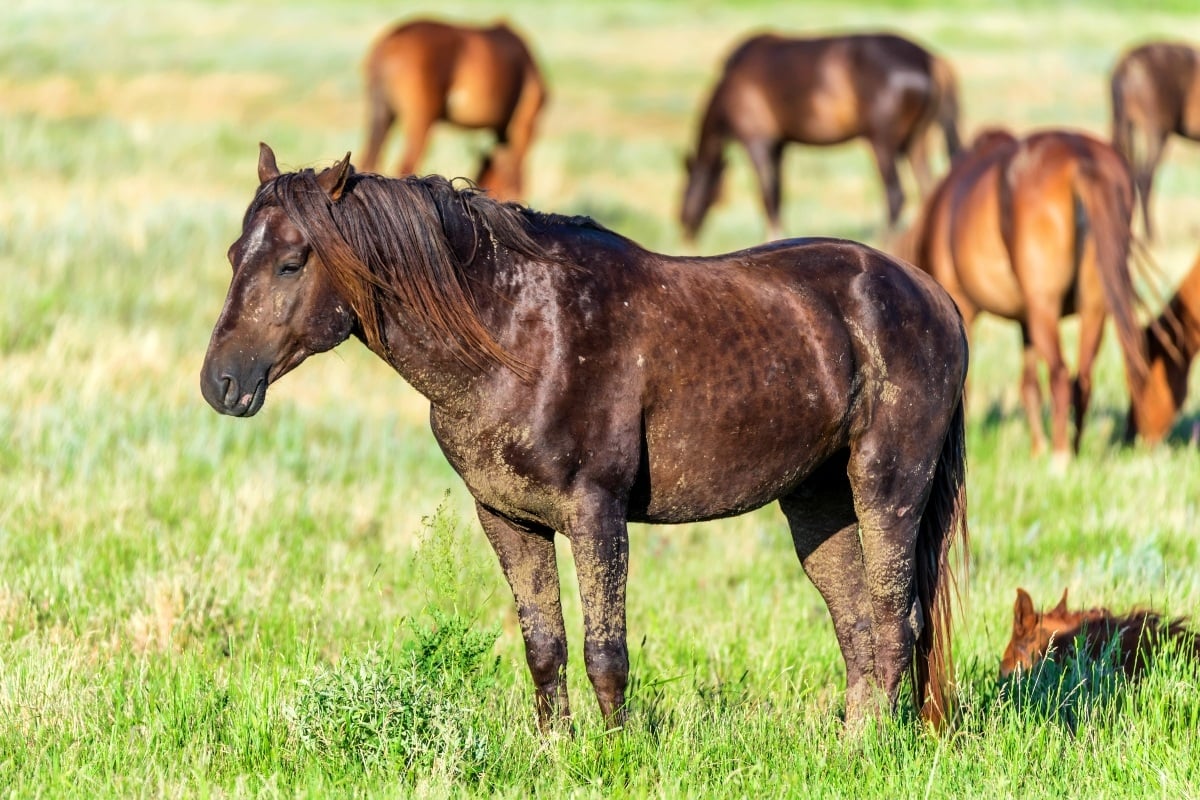Horse Breeding Season Months

On horse farms, the breeding shed is perhaps the most important place for accurate recordkeeping.1 Understanding as much as possible regarding the mare's breeding cycle can give horse owners and breeders an edge with regard to achieving their breeding objectives. Records for breeding management, estimating foaling dates and evaluating breeding performance go a long way toward cultivating such an understanding and for maintaining sound breeding practices.
Record evaluation is essential in the horse breeders decision making. The type and detail of records will depend upon the management of breeding practices on each facility, but the overall requirements are generally the same.
Mares begin to come into estrus early in the Spring, with their estrous cycle being approximately 21 days. Usually, the mare will be receptive to breeding for about five days toward the end of her cycle. Most of the available literature maintains that the mare should be bred within the 12 hour period prior ovulation in order to have the best chance of getting her in foal.
The Breeding Life Cycle of the Mare
Fillies reach sexual maturity at approximately 18 months of age. At this point, she will begin to cycle regularly during Spring, Summer and early Fall, however most breeders maintain that the optimal age group for easy breeding will be found with mares between the ages of about 4 and 12.2
"The primary environmental factor causing mares to cycle normally is increased hours of light (photoperiod). Artificial lighting can be used to induce mares to cycle earlier in the year."3 The estrous cycle, which is to be distinguished from estrus itself (the "heat" portion of the estrous cycle), begins to normalize in late April or early May through August, which is the normal breeding season for horses. During this period, mares will have an estrous cycle of approximately 21 days.
The estrous cycle consists of two phases:
- The estrus phase (in heat), and
- The diestrous phase (out of heat).
Estrus typically lasts for approximately six days, but can be as short as four or as long as ten days. This is usually individually dependent on the mare. The diestrus portion of the cycle lasts approximately 15 days, but can vary from 12 to 18 days. From September through March, mares stop cycling normally. This is called anestrus.
As increasing daylight stimulates the receptor centers in the brain to trigger reproductive hormones, these hormones begin the pattern of regular periods of estrus, also known as heat. The estrous cycle is the time period from one ovulation to the next. The average cycle is 22 days and this can vary by a few days especially at the beginning or ending of breeding season. "Generally in March, many mares begin to develop ovarian activity. This early activity may not be accompanied by ovulation, but beginning in May, with longer daylight hours, warmer temperatures, and the arrival of green grass, nearly all mares are cycling consistently, with conception rates peaking in June."4
| Breeding Life Cycle of the Mare | |||||
| Sexual Maturity | Estrous Cycle | Estrus (Heat) Length | Diestrus (not fertile) length | Gestation Period | Postpartum Heat |
| Appx. 18 months | 22 days | 6 to 8 days | 14 to 16 days | 340 days | 7 days after parturition |
While private horse owners breeding their mare for the first time may need to rely on research, fellow equestrians and their veterinarian for input, breeding operations (horse farms) have developed comprehensive systems for ensuring that they meet their quotas and continue to keep their operations financially viable.
The goal of a breeding farm is to produce live foals. To determine whether the goal was reached several ratios are calculated from breeding records. The most routine evaluation is pregnancy rate. This is the number of mares pregnant on a specific day, divided by the number bred. Pregnancy rate can be determined from one ovulatory period or on the total breeding season. For example, early pregnancy checks of 20 mares revealed that 17 had embryos and three were open. The pregnancy rate would be 17, divided by 20, multiplied by 100.
Pregnancy rate = (17/20) x 100 = 85% pregnant
Foaling rates are the percent of matings that produce a live foal. It is determined by dividing the number of live foals by the number of mares bred. For example, foaling rate would be 75 percent if 15 of 20 mares bred produced foals.
Foaling rate = (15/20 X 100) = 75%1
In most cases (outside of a horse farm), once a mare is in estrus, it is recommended that the breeder solicit a veterinarian to monitor the mare closely for ovulation. The foundation of a good reproductive program starts with a veterinarian that has good knowledge of equine reproductive physiology and is experienced in managing mares during estrus and early pregnancy to achieve optimal results.5
Planning For the Long Term
Many large and small horse breeding operations have crafted breeding cycle charts for monitoring their mares and for planning their seasonal breeding. While these can be helpful to the horse owner who is planning to breed their mare, seasoned breeders typically advise that owners draw up their own based upon the particulars of their mare(s) since all animals vary.
While fillies do become sexually mature at approximately 18 months, the literature maintains that they are still experiencing growth during this time that may be hindered by pregnancy. Thus, it is recommended that the ideal age to begin foaling is approximately four years of age. Mares are capable of continuing to breed until late in life and do not usually suffer ill effects if nutrition and condition are maintained.4
1okstate.edu.
2equine-reproduction.com.
3omafra.gov.
4equimed.com.
5Rosenthal, M. Breeding Basics: The Mare’s Reproductive Cycle. The Horse, Oct. 2011.



